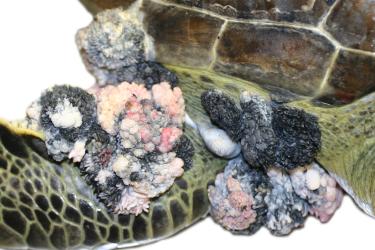What’s going on?
Sea turtles face an array of threats in Florida including coastal development and tourism, ocean and plastic pollution, and illegal consumption of their meat and eggs. One disease threatening sea turtles worldwide is fibropapillomatosis. Also called “FP”, this debilitating and mysterious disease causes cauliflower-shaped tumors on external soft parts and internal organs of sea turtles. According to SEE Turtles, over 50% of green turtles found in Florida’s Indian River are afflicted by FP.

The earliest reports of FP in sea turtles are from Florida in the late 1800s, but the first documentation of the disease in scientific literature occurred in the 1930’s in green sea turtles in the Florida Keys. Now occurring worldwide, FP has since been found in all 7 sea turtle species, but green turtles remain the most commonly and severely impacted.
Research has shown that FP is associated with a herpesvirus called Chelonid FP-Associated Herpesvirus. Since the virus has also been detected in clinically healthy sea turtles, it’s believed that localized human-induced environmental changes, such as ocean pollution, also contribute to the formation of FP tumors in turtles infected by the virus. Further research is being conducted to determine the exact cause of this disease.
For sea turtles found with FP tumors, veterinarians surgically remove the tumors and provide treatments for conditions related to FP. In Florida, The Turtle Hospital in Marathon Key rehabilitates sea turtles suffering from a variety of ailments, but most commonly treats FP.
Why it matters.
Tumors can slow down sea turtles and make them more vulnerable to predation and collisions with boats. Tumors around the mouth can also impair breathing and feeding, while tumors around the eyes can impact vision and may lead to blindness.
Discovering the cause of these harmful tumors and developing strategies to reduce or eliminate FP is essential for protecting sea turtle populations. Currently, all five of Florida’s sea turtle species are listed as either endangered or threatened. While sea turtle populations in Florida have grown in recent years thanks to conservation efforts, reducing the number of FP-related deaths is important for further supporting endangered and threatened populations.
What you can do.
Do what you can to protect healthy sea turtles, support future generations, and alert wildlife professionals of any sea turtles that seem unwell or have FP tumors.
- For stranded sea turtles, contact your local stranding network or report online
- Properly dispose of trash, debris, and fishing/boating gear
- Learn the Do’s and Don’ts of sea turtle nesting season
Check out our recent Action of the Week: Prepare for Sea Turtle Nesting Season for more information!
Learn more about the amazing sea turtle research going on in Florida at The Archie Carr Center for Sea Turtle Research (ACCSTR) at the University of Florida by following @ACCSTR and visiting their website.